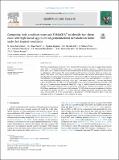| dc.contributor.author | Soto-Barrientos, Natalia | |
| dc.contributor.author | Chan-Pérez, J.I. | |
| dc.contributor.author | España-España, E. | |
| dc.contributor.author | Novelo-Chi, L.K | |
| dc.contributor.author | Palma-Ávila, I. | |
| dc.contributor.author | Ceballos-Mendoza, A.C. | |
| dc.contributor.author | Sarabia-Hernández, J.A. | |
| dc.contributor.author | Santos-Ricalde, R.H. | |
| dc.contributor.author | Cámara-Sarmiento, R. | |
| dc.contributor.author | Torres-Acosta, J.F.J. | |
| dc.date.accessioned | 2019-10-28T15:39:35Z | |
| dc.date.available | 2019-10-28T15:39:35Z | |
| dc.date.issued | 2018-08-16 | |
| dc.identifier.uri | https://doi.org/10.1016/j.smallrumres.2018.08.011 | |
| dc.identifier.uri | http://hdl.handle.net/11056/15257 | |
| dc.description.abstract | Data from a targeted selective treatment (TST) survey in three sheep farms was used to compare body condition
scores (BCS) ≤ 2 and FAMACHA© scores ≥4 or ≥3 as criteria to identify ewes with ≥ 750 eggs per gram of
faeces (EPG), and to confirm whether that EPG threshold allowed maintaining a large proportion of animals with
no anthelmintic (AH) treatment. The survey included monthly data from all grazing adult ewes in three commercial farms. Farms 1 and 3 were surveyed for 11 months, and Farm 2 for 6 months, with a total of 7342 events
recorded. Mean monthly population consisted of 330 ewes (Farm 1), 129 ewes (Farm 2) and 265 ewes (Farm 3).
The FAMACHA© scores and BCS of adult ewes were recorded monthly. Ewes with FAMACHA© ≥ 4 or BCS ≤ 2
were faecal sampled to determine faecal egg counts (FEC) (2788 events). Ewes with ≥ 750 EPG were treated
with an AH (658 events). The TST survey showed that BCS ≤ 2 was the best criteria to find ewes with FEC ≥ 750
EPG, with 1.1% false negatives. Meanwhile, FAMACHA© ≥4 or ≥3 failed to identify half of the events with ≥
750 EPG (50–55% false negatives). Thus, the TST scheme could focus on screening ewes with BCS ≤ 2, and the
FEC of those animals can avoid unnecessary AH treatments. The TST scheme was easier to implement at the farm
with largest ratio of ewes with BCS > 2, as fewer ewes were sampled and treated, compared to farms where
many ewes had BCS ≤ 2. In the surveyed farms a threshold of ≥ 750 EPG resulted in 63.5% of all ewes
maintained with no AH treatment for the duration of the survey. | es_ES |
| dc.description.abstract | Los datos de una encuesta de tratamiento selectivo dirigido (TST) en tres granjas de ovejas se usaron para comparar puntajes de condición corporal (BCS) ≤ 2 y puntajes de FAMACHA © ≥4 o ≥3 como criterios para identificar ovejas con ≥ 750 huevos por gramo de heces (EPG) ), y para confirmar si ese umbral de EPG permitió mantener una gran proporción de animales sin tratamiento antihelmíntico (AH). La encuesta incluyó datos mensuales de todas las ovejas adultas que pastan en tres granjas comerciales. Las granjas 1 y 3 fueron encuestadas durante 11 meses, y la granja 2 durante 6 meses, con un total de 7342 eventos registrados. La población mensual promedio consistió en 330 ovejas (Granja 1), 129 ovejas (Granja 2) y 265 ovejas (Granja 3). Los puntajes FAMACHA © y BCS de ovejas adultas se registraron mensualmente. Las ovejas con FAMACHA © ≥ 4 o BCS ≤ 2 se tomaron muestras fecales para determinar el recuento de huevos fecales (FEC) (2788 eventos). Las ovejas con ≥ 750 EPG fueron tratadas con un AH (658 eventos). La encuesta TST mostró que BCS ≤ 2 fue el mejor criterio para encontrar ovejas con FEC ≥ 750 EPG, con 1.1% de falsos negativos. Mientras tanto, FAMACHA © ≥4 o ≥3 no pudieron identificar la mitad de los eventos con ≥ 750 EPG (50-55% de falsos negativos). Por lo tanto, el esquema TST podría centrarse en la detección de ovejas con BCS ≤ 2, y la FEC de esos animales puede evitar tratamientos innecesarios de AH. El esquema TST fue más fácil de implementar en la granja con la mayor proporción de ovejas con BCS> 2, ya que se muestrearon y trataron menos ovejas, en comparación con las granjas donde muchas ovejas tenían BCS ≤ 2. En las granjas encuestadas resultó un umbral de ≥ 750 EPG en el 63.5% de todas las ovejas mantenidas sin tratamiento AH durante la duración de la encuesta. | |
| dc.language.iso | en | es_ES |
| dc.publisher | Elsevier B.V. | es_ES |
| dc.rights.uri | http://creativecommons.org/licenses/by-nc-nd/4.0/ | |
| dc.subject | NEMATODE | es_ES |
| dc.subject | SHEEP | es_ES |
| dc.subject | HUMID TROPICS | es_ES |
| dc.subject | NEMATODA | es_ES |
| dc.subject | OVEJAS | es_ES |
| dc.subject | TROPICOS HUMEDOS | es_ES |
| dc.title | Comparing body condition score and FAMACHA© to identify hair-sheep ewes with high faecal egg counts of gastrointestinal nematodes in farms under hot tropical conditions | es_ES |
| dc.type | http://purl.org/coar/resource_type/c_6501 | es_ES |
| dc.description.procedence | Escuela de Medicina Veterinaria | |


